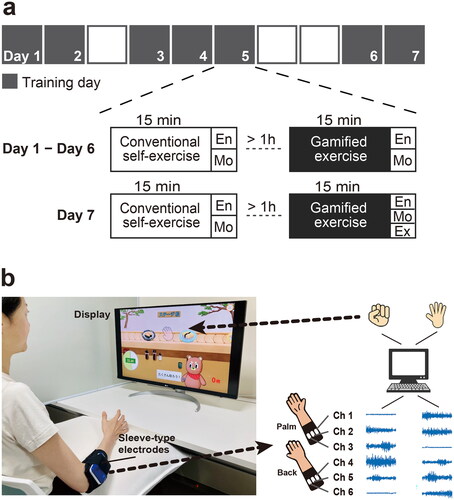Figures & data
Figure 1. Experimental protocol and developed electromyography-controlled gamified system. (a) Example of protocol. A participant performed gamified exercise and conventional self-exercise for 15 min per day and repeated for non-consecutive seven days. Each day, both exercises were performed in a fixed order, separated by at least one hour between them. A participant was asked to rate the exercises regarding enjoyability (En), motivation to continue (Mo), and expectancy of effectiveness (Ex) based on numerical rating scales. Expectancy of effectiveness was evaluated only on the last day. (b) An overview of gamified exercise for training hand-finger movements. This is an example of the game contents at stage 3. Muscle activities were measured from the forearm using a custom-made elastic sleeve with 6 pairs of wireless surface electromyography electrodes. When muscle activity patterns matched the reference and the level of activity exceeded a certain level, characters’ movements were generated.

Table 1. The finger movements required in each stage.
Table 2. Participants’ characteristics.
Figure 2. Numerical rating scale (NRS) scores for a) enjoyability, b) motivation to continue, c) expectancy of effectiveness for the gamified exercise, and conventional self-exercise. Mean scores for enjoyability and motivation to continue are presented using black dots for the gamified exercise and white dots for conventional self-exercise. Error bars indicate standard deviation. Individual scores for expectancy of effectiveness are shown in each dot, and mean scores are shown in horizontal lines.

Supplemental Material
Download MS Word (2.5 MB)Data availability statement
The data that support the findings of this study are available from the corresponding authors, upon reasonable request.
